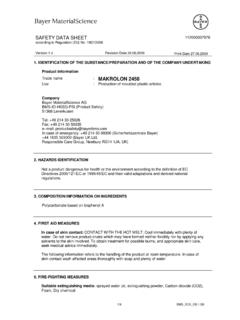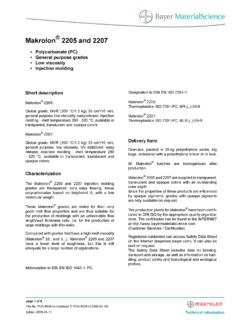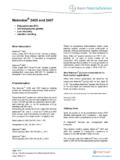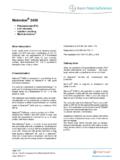Transcription of Makrolon 2605, 2607, 2805 and 2807 - lidorr.com
1 Page 1 of 12 File No. PCS-8065 en (replaces TI KU28004 dated 2004-06-25 and KU28006 dated2004-07-12)Edition 2008-03-19 Technical InformationMakrolon 2605, 2607, 2805 and 2807 Polycarbonate (PC) General purpose grades Medium viscosity Injection moldingShort descriptionMakrolon 2605:Global grade; MVR cm /10 min;General purpose; Medium viscosity; Easy release;Injection molding - Melt temperature 280 - 320 C;Available in transparent, translucent and opaquecolorsMakrolon 2607:Global grade; MVR cm /10 min;General purpose; Medium viscosity; UV stabilized;Easy release; Injection molding - Melt temperature280 - 320 C; Available in transparent, translucent andopaque colorsMakrolon 2805:Global grade; MVR cm /10 min;General purpose; Medium viscosity; Easy release;Injection molding - Melt temperature 280 - 320 C;Available in transparent, translucent and opaquecolorsMakrolon 2807:Global grade; MVR cm /10 min;General purpose; Medium viscosity; UV stabilized;Easy release; Injection molding - Melt temperature280 - 320 C; Available in transparent, translucent andopaque colorsCharacterizationThe Makrolon 2605, 2607, 2805 and 2807 injectionmolding grades are transparent, medium viscosity,linear polycarbonates based on bisphenol 2605 and 2607 are largely comparable withMakrolon 2805 and 2807.
2 The basic difference be-tween Makrolon 2605 and 2805 and also betweenMakrolon 2607 and 2807 is their Makrolon grades have a more favorableflowability than the Makrolon to DIN EN ISO 1043-1: PCDesignation to DIN EN ISO 7391-1: Makrolon 2605:Thermoplastics ISO 7391-PC,MR,(,,)-18-9 Makrolon 2607:Thermoplastics ISO 7391-PC,MLR,(,,)-18-9 Makrolon 2805:Thermoplastics ISO 7391-PC,MR,(,,)-09-9 Makrolon 2807:Thermoplastics ISO 7391-PC,MLR,(,,)-09-9 These are amorphous thermoplastics which, wheninjection molded, provide a unique combinationof strength, stiffness and hardness, together withtoughness and breaking strength. The heat resistanceof these Makrolon grades extends up to 135 C,depending on the type of stress placed on thecomponent. This, together with the low-temperatureimpact strength that is sufficient for a large number ofapplications, means that these grades can be usedover a broad temperature range (-100 to +135 C).
3 New Makrolon product nomenclature for foodcontact applicationsWhen food contact applications are specified, we willsupply only Makrolon grades with the final digits 06or 56. The existing Makrolon grades with 08 and 58as the final digits will be available only for applicationsinvolving medical devices**.Details on this can be found in our Technical Information Sheet." Makrolon 2656, 2806 and 2856"" Makrolon 2558, 2658, 2808 and 2858"page 2 of 12 File No. PCS-8065 en (replaces TI KU28004 dated 2004-06-25 and KU28006 dated2004-07-12)Edition 2008-03-19 Technical InformationDelivery formGranules, packed in 25-kg polyethylene sacks, FIBC(flexible intermediate bulk containers big bags),large cartons with a polyethylene inliner or in Makrolon batches are homogenized injection molding grades Makrolon 2605, 2607, 2805 and 2807 are supplied in transparent,translucent and opaque colors with an outstandingcolor production plants for Makrolon have been certifi-cated to DIN ISO by the appropriate quality organiza-tions.
4 The certificates can be found in the INTERNETat (Customer Services / Certificates).Registered customers can access Safety Data Sheeton the Internet ( ). It can also besent on Safety Data Sheet includes data on labeling,transport and storage, as well as information on han-dling, product safety and toxicological and engineering:Junction box lids, bulb sockets, switch covers, switchhousings, functional parts for the electrical industryLighting engineering:Light diffusers, light housings, light reflectorsHousehold articles/commodities:Shaver housings, food processor parts, ironsTransport systems:Warning lights, signal lights, road signs, traffic lighthousingsSafety applications:Protective goggles, helmet visorsProperties (see also table)The key characteristic features of molded parts inMakrolon 2605, 2607, 2805 and 2807 are:-outstanding light transmission (transparentgrades)-high strength and impact strength-dimensional stability, very low dimensionalchanges-high heat resistance-excellent electrical and dielectric propertiesMechanical propertiesMolded parts made from the Makrolon and of grades are considered to be rigid materialson account of their strength and hardness, but alsoelastic materials on account of their low level of correlation between mechanicalproperties and temperature is striking; up to 140 C,stress-free parts remain hard and parts made of grades in the series possess a particularly favorable energyabsorption capacity under impact-type loads.
5 Thematerial is not, however, suitable for sliding bearingsor toothed wheels where considerable stressingprevails. If parts are to be produced that will beexposed to dynamic loading, we recommend thatpractical service tests be conducted in excess of 20 MPa at 20 C and in excessof 10 MPa at 60 C can lead to surface crackingafter a period of more than 104 hours. If the parts areemployed in media other than air, then the permissiblevalues may differ. Over and above this, allowancemust be made for reduction factors as a function of thedifferent influencing parameters ( the molded partgeometry, gate design and processing conditions).These reduction factors must be specified for eachindividual of coloring on thoughnessThe majority of transparent colors do not cause anychange in properties, or at least no major pigments affect toughness depending on thetype and quantity of pigment 3 of 12 File No.
6 PCS-8065 en (replaces TI KU28004 dated 2004-06-25 and KU28006 dated2004-07-12)Edition 2008-03-19 Technical InformationThermal propertiesComponents made from the Makrolon series of grades are noted for their high heatresistance. At low loading levels ( inherent weight)the parts do not undergo any essential deformationat up to 135 C. At above 145 C (glass transitiontemperature), Makrolon starts to soften and, as fromapproximately 220 C, it assumes the molten higher temperatures are required, however,before it attains a flowability that will permit it tobe processed on injection molding machines andextruders. Lengthy periods of heating to temperaturesin excess of 320 to 340 C leads to thermaldecomposition, with carbon dioxide being split off, coefficient of thermal expansion is lower than formany other thermoplastics. If the material is subjectto temperatures in excess of some 80 C for longperiods of time, then a structural change will occur,as a function of the temperature and duration ofthe thermal treatment, which is characterized by aslight increase in the tensile and flexural strengthand a reduction in the notched impact strength.
7 Themaximum permitted service temperature for partsmade of Makrolon and grades depends onthe shape of the molded part, the type of loadingand the specifications. The temperature indices toIEC 60216-1 and UL 746 B can be regarded aspractical reference values for the permitted maximumtemperatures during long-term a component is subject to a high temperatureand mechanical loading simultaneously, the creepbehavior must be taken into account. Further detailson this can be found in the CAMPUS propertiesThe favorable electric properties of molded parts inMakrolon and grades are not influencednotably by temperature fluctuations or by ambienthumidity. The change in the measured values athigher frequencies must be taken into account whenMakrolon is used in the high-frequency sector. Afurther advantage is that no electrolytic corrosion propertiesMakrolon parts made from grades in the series have a high refractive index of virtually colorless, transparent grades possessa light transmission of up to 89 % in the visiblerange.
8 Ultraviolet light, by contrast, is absorbed andleads to yellowing and a reduction in the impactstrength in the course of time. In all cases whereUV radiation is emitted, and particularly when itis emitted in conjunction with high temperatures, aUV-stabilized grade should be used ( Makrolon 2607, 2807). Finished parts, and particularly lamp covers,can be given subsequent UV protective treatment towards moisture and water(hydrolysis resistance)Molded parts in Makrolon and absorb to % water at room temperature with 50 %relative humidity. The physical/technological proper-ties remain virtually unaffected. The dimensionalchanges are similarly insignificant. With immersion inwater and rising temperatures, values of only % orso are achieved. The steam permeability, measuredon 100 m thick film, is 15 g/m d. A notable levelof permeability also exists for other gases (hydrogen,carbon dioxide, sulfur dioxide, helium and ethyleneoxide).
9 Where hydrolysis resistance is required, use shouldbe made of Makrolon 2656, 2806 or resistanceMakrolon is resistant to mineral acids, even in highconcentrations, to a large number of organic acids( carbonic acid, lactic acid, oleic acid and citricacid), to oxidation and reducing agents, neutral andacidic saline solutions, a range of greases and oils,saturated aliphatic and cycloaliphatic hydrocarbons,and also alcohols, with the exception of methylalcohol. Makrolon is destroyed by alkaline solutions,ammonia gas and its solution, and amines. Makrolondissolves in a large number of industrial organic compounds, such as benzene, acetoneand carbon tetrachloride, cause it to 4 of 12 File No. PCS-8065 en (replaces TI KU28004 dated 2004-06-25 and KU28006 dated2004-07-12)Edition 2008-03-19 Technical InformationWeatherabilityWeatherability is generally adequate for a largenumber of applications and particularly for indoorapplications.
10 For stringent requirements, use of theUV stabilized grade, Makrolon 2607 or 2807, isrecommended. Maximum resistance can be attainedin finished parts through the subsequent applicationof a UV protective / drying1) Makrolon must be dried prior to processing. Forinjection molding, no more than % residualmoisture may be present in the granules and, forextrusion, no more than %. Moisture in the meltleads to surface defects as well as to an increasedreduction in molecular should be dried in suitable dryers at120 drying time for moist granules is largely a functionof the nature and type of the drying unit and cantotal 2 to 12 hours depending on the drying times of 2 to 4 hours are sufficient in modernhigh-speed dryers. One means of dispensing withpre-drying is for the moisture to be removed duringmelting with the aid of a degassing unit, as has beenstandard practice in extrusion for a long molding1) Makrolon can be processed on all modern injectionmolding machines.








